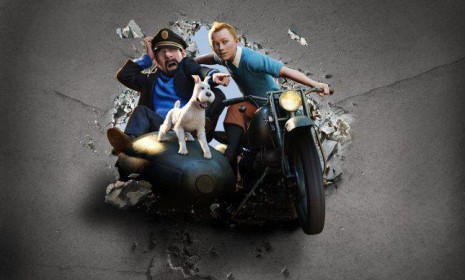Will Steven Spielberg's Tintin 'save motion-capture animation'?
The film opens strongly in Europe, suggesting that eerie, almost-lifelike animation can work — at least if it's based on beloved graphic novels

When Disney's Mars Needs Moms brought in just $6.9 million in its opening weekend earlier this year, commentators suggested the $175-million flop would sound the death knell of motion-capture animation. The technique, in which the movements of real actors filmed on a blank set are turned into computer animation, has delivered a number of disappointments from Beowulf to Polar Express; the consensus is that audiences don't connect with the characters' creepy, near-lifelike appearance. Turning that thesis on its head is Steven Spielberg's motion-capture The Adventures of Tintin, based on the immensely popular European comics about a young Belgian reporter and his dog. (Watch the trailer below.) The film, which hits the U.S. in December, opened abroad to a whopping $55.8 million over the weekend. Could Spielberg and Tintin "save motion-capture animation"?
Yes. Tintin proves that motion-capture can work: The film's "promising start" suggests audiences will embrace motion capture when it's done right, says Joshua L. Weinstein at The Wrap. In France, for instance, Tintin scored "the biggest opening ever for an original, non-sequel Hollywood film." This "spectacular" visual feat really draws audiences in, Rory Bruer, of film distributor Sony, tells The Wrap in the same article. "You couldn't ask for a film that's more immersive and incredible to look at than Tintin."
"Can Steven Spielberg's Tintin save motion-capture animation?"
The Week
Escape your echo chamber. Get the facts behind the news, plus analysis from multiple perspectives.

Sign up for The Week's Free Newsletters
From our morning news briefing to a weekly Good News Newsletter, get the best of The Week delivered directly to your inbox.
From our morning news briefing to a weekly Good News Newsletter, get the best of The Week delivered directly to your inbox.
No. Our brains were wired to hate this style: Though better than ever, Tintin's motion-capture animation is still not "good enough," says Steve Rose at Britain's Guardian. "It's a paradox of animation that you can put arms and a face on a spoon… and it looks cute," but if a character is too lifelike, "the brain no longer reads it as good animation," but as reality gone awry. Video game designers have long struggled with this problem. Maybe one day we'll find a solution "where we can't tell the difference between what's animated and what's real." Though that idea is "potentially more terrifying than all the zombies, Chuckies and glazed-over Tintin characters put together."
"Tintin and the Uncanny Valley: When CGI gets too real"
Tintin deserved better: "The motion-capture animation [in Tintin] makes all the characters look like… marionettes," says Peter Bradshaw at the Hindustan Times. It has neither "the charm, clarity and style" of the Tintin books' illustrations, nor "the immediacy and panache of flesh-and-blood human beings." You can't help but imagine how much better the movie would be if it were hand drawn or live action. Instead, we get a disappointing Tintin that's "flat and robotic and a little bit aimless."
A free daily email with the biggest news stories of the day – and the best features from TheWeek.com
-
 5 fairly vain cartoons about Vanity Fair’s interviews with Susie Wiles
5 fairly vain cartoons about Vanity Fair’s interviews with Susie WilesCartoon Artists take on demolition derby, alcoholic personality, and more
-
 Joanna Trollope: novelist who had a No. 1 bestseller with The Rector’s Wife
Joanna Trollope: novelist who had a No. 1 bestseller with The Rector’s WifeIn the Spotlight Trollope found fame with intelligent novels about the dramas and dilemmas of modern women
-
 Codeword: December 20, 2025
Codeword: December 20, 2025The daily codeword puzzle from The Week